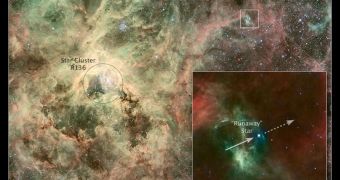It's no longer a secret to astronomers that certain types of space structures that contain stars can kick some of these fireballs out. This goes for binary systems, stellar nurseries, solar systems, galaxies and so on. However, detecting the occurrence is very difficult, and not much has thus far been inferred about the phenomenon. A series of studies from the famous Hubble Space Telescope is now about to clear some of those mysteries. Recently, scientists used the advanced observatory to look at the outer fringes of 30 Doradus Nebula, a space structure known more commonly as the Tarantula Nebula. The team identified a massive star in the process of being kicked out, while traveling extremely fast.
These celestial objects are called runaway stars, and they can generally be told apart from other stars via the fact that they move at unjustifiably-high speeds. This particular object, which is no less than 90 times more massive than our own Sun, has been found to be traveling through the outskirts of its home nebula at a speed of about 250,000 miles per hour (400,000 kilometers per hour). According to the group, it could be that the object has been kicked out by its siblings, the other massive stars in the stellar nursery.
The Tarantula Nebula is a highly-active source of new stars, and it is located in the Large Magellanic Cloud, one of our closest neighboring galaxies. Details of the speed and mass of the runaway star have been collected using the new, advanced Cosmic Origins Spectrograph (COS) instrument, which was installed on Hubble last year. The sensitive data collected by COS allowed for astronomers to determine that the large star most likely covered a distance of no less than 375 light-years from its suspected home by now. The experts add that the fireball was most likely produced in a giant star cluster called R136.
“These results are of great interest because such dynamical processes in very dense, massive clusters have been predicted theoretically for some time, but this is the first direct observation of the process in such a region. Less massive runaway stars from the much smaller Orion Nebula Cluster were first found over half a century ago, but this is the first potential confirmation of more recent predictions applying to the most massive young clusters,” says COS team member Nolan Walborn, who also holds an appointment at the Baltimore, Maryland-based Space Telescope Science Institute.
“It is generally accepted […] that R136 is young enough that the cluster's most massive stars have not yet exploded as supernovae. This implies that the star must have been ejected through dynamical interaction,” adds Danny Lennon, a team member for COS who is also based at the STScI, Space reports.

 14 DAY TRIAL //
14 DAY TRIAL //